Laser rangefinders (LRF) are commonly used instruments for detecting the distance between a fixed or moving object and an observer. Applications range from simple consumer instruments for sports and recreation, such as golf, archery and shooting, to specialized instruments for surveying and construction, forestry, archaeology and manufacturing. Some of the most demanding applications are in the fields of navigation, defense and law enforcement, where long range, accurate measurements are critical.
In the simplest terms, an infrared (IR) laser rangefinder emits a pulse of narrowly collimated light at a selected target, measures the time it takes for light reflected from that target to return to the instrument, and calculates the distance to the target from that data. The light source is a laser diode and the sensor that detects the reflected light is either a photodiode (PD) or an avalanche photodiode (APD) that generates a current in response to the laser pulse.
The main functional blocks of a typical laser rangefinder. The laser diode, photodetector and signal processing functions are the key features that define the performance parameters.
While consumer rangefinders may have an operating range of a few hundred meters to approximately 2.5 kilometers, some models of professional instruments can reach ranges of 20 kilometers to 30 kilometers under favorable environmental conditions.
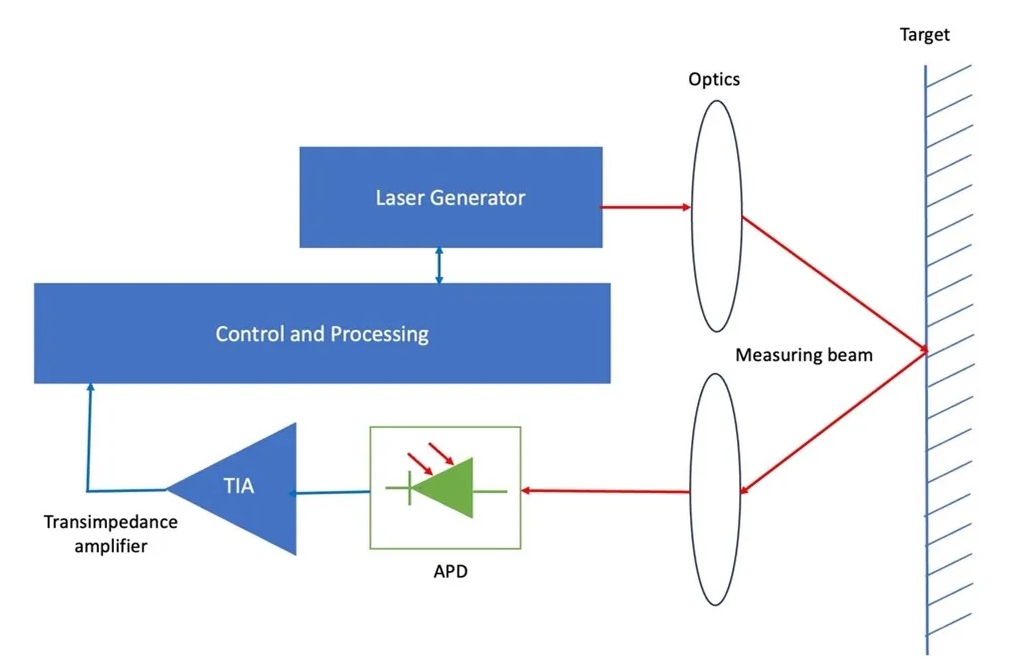
How pulse wavelength affects LRF performance?
LRFs operate primarily at 905 nm or 1,550 nm. The availability of detectors suitable for sensing these wavelengths has made them the industry standard.
Silicon (Si) PDs and APDs are used at 905 nm, while InGaAs APDs (compound semiconductors) are used at 1,550 nm, when their sensitivity is highest. Germanium (Ge) sensors can also be used at longer wavelengths, but they exhibit higher noise and are much less sensitive than InGaAs devices, as shown below.
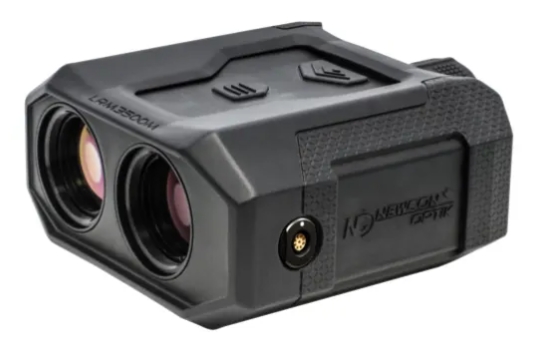
A compact, professional 1,550-nm laser rangefinder with an operating range of up to 5.5 km and ±1-meter accuracy.
Most short-range professional laser rangefinders operate at 905 nm. Silicon sensors and near-infrared lasers are generally less expensive than the InGaAs devices used in 1,550 nm systems and offer sufficient performance for many applications. However, 1,550 nm systems have significant advantages in some applications, and their performance is critical for some of these applications.
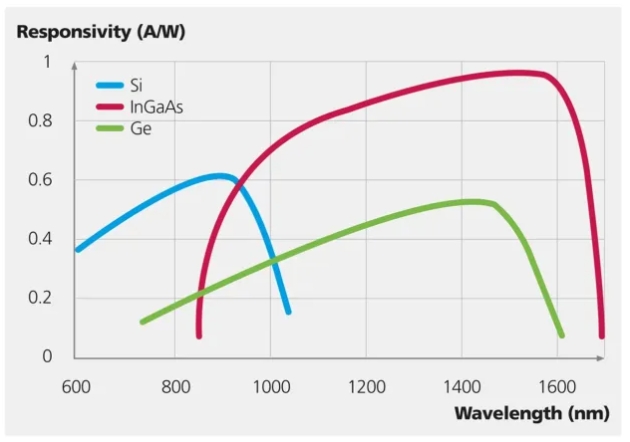
Responsivity curves for Si, Ge and InGaAs APD technologies.
Lasers with up to 1,000 times more power than the 905 nm version can be used in 1,550 nm systems while maintaining Class 1 "human eye safety". This means they are safe for the naked eye under predictable operating conditions. The 1,550 nm laser enters the eye with less risk of retinal damage because the longer wavelength of 1,550 nm and its distance from the visible spectrum compared to 905 nm means that the light does not pass through the retina and focus on the cornea. The higher power facilitates penetration of fog, dust or other particles. This, coupled with the 1,550 nm beam's greater obscurity, lower dispersion and better optical collimation, means that longer detection distances and greater accuracy are possible.
How APDs work?
APDs operate at a reverse voltage slightly below the breakdown voltage. This produces maximum internal gain as charge carriers, electrons and holes are excited by the absorbed photons, accelerated in the internal electric field and secondary carriers are produced. The avalanche process amplifies the photocurrent, which makes the APD a highly sensitive photodetector.
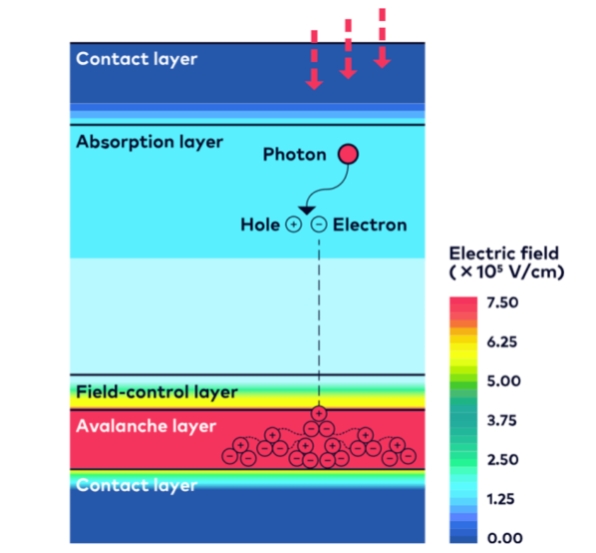
The avalanche diode internal gain mechanism
Silicon APDs can operate at high gains (typically between 50 and 1,000), but conventional InGaAs devices are limited to gains between 10 and 40 due to their high inherent noise characteristics. Above this level, the amplified noise affects the performance of the transimpedance amplifier (TIA) to which the APD is connected. The TIA is a conditioning amplifier that converts the current from the diode into a voltage that, for a single pulse system, then powers the time-to-digital converter. Multipulse signals are integrated and averaged using a Field Programmable Gate Array (FPGA) or Digital Signal Processor, or processed in a time-dependent circuit.
What is a 'noise-free' InGaAs APD?
The University of Sheffield announced a new InGaAs APD technology in early 2024 after eight years of research. By introducing antimony alloys into the conventional InGaAs manufacturing process, it is now possible to produce devices that operate at gains in excess of 120 without excessive noise. These devices also exhibit fast overload recovery, temperature drift 10 times lower than antimony-free devices, and stable high-temperature performance.
They are called "Noise Free InGaAs APDs" but are not strictly noise free, the noise reduction is greater than an order of magnitude compared to other best-in-class InGaAs APDs, so Phlux defines a "Noise Free" APD as one that exceeds the noise limit. Therefore, Phlux defines a "noise-free" APD as one that has a low enough noise-exceeding APD coefficient to achieve APD gains in excess of 100 without degrading the signal-to-noise ratio (SNR).
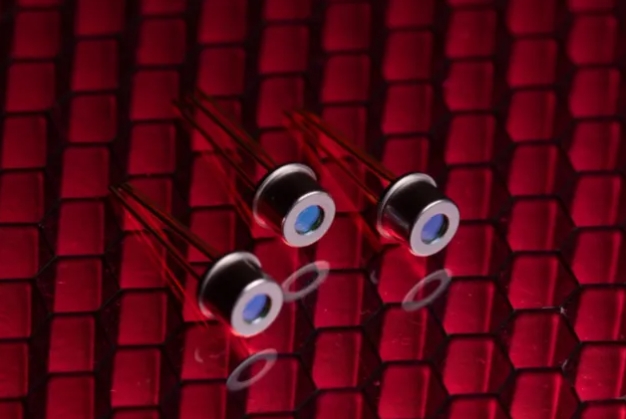
The new class of “noiseless” InGaAs APDs can be dropped into existing LRF designs to give range improvements of up to 50%.
How noise-free InGaAs APDs lead to better LRFs?
LRF designs vary widely. The performance of these instruments is impacted by the quality of the design as well as the performance of various electronic, mechanical and optical components. Initial estimates suggest that using noise-free InGaAs APDs as a direct replacement for existing components can extend the operating range by as much as 50% for typical specialized instruments.
You can also reduce the power of the laser diode by replacing the existing APD with Phlux's noise-free InGaAs technology without reducing the range of the instrument. Lower laser power simplifies thermal management and reduces optics requirements. This reduces the size and cost of the instrument's infrared components by 30% and 40%, respectively. In addition, the lower power laser means longer recharge intervals for battery-powered instruments. Finally, the new APDs are more thermally stable, allowing for more accurate measurements under varying environmental conditions.
As with all instruments, there are design tradeoffs, and power consumption versus range is probably the most important. But now, replacing a single diode (the APD infrared sensor) can go a long way toward alleviating these tradeoffs in 1,550 nm long-range laser rangefinders.
For more articles on RF, it can be viewed here: www.perceptive-ic.com



























